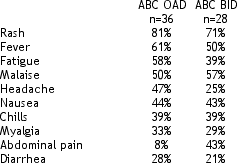 |
 |
 |
| |
|
Abacavir Once Daily Study
|
| |
| |
Reported by Jules Levin
As we increasingly closer to once daily dosing regimens in HIV, today at this afternoon’s HIV Slide Session at ICAAC Brian Gazzard reported study results for once daily abacavir (Ziagen). This study compared abacavir (ABC) 600 mg once daily (OAD) to ABC 300 mg twice daily in combination with 3TC 300 mg once daily and efavirenz 600 mg once daily. Patients in the study were treatment-naïve and results were reported after 48 weeks on study treatment. At this conference Pilero reported in abstract A-1797 that the abacavir intracellular half life in his study was 20 hours and he concluded that this provides pharmacologic support for the administration of abacavir once daily.
In the ZODIAC Study (CNA30021) –Ziagen Once Daily in Antiretroviral Combination therapy—385 patients were randomized to ABC BID and 385 to ABC BID. Each study group also received placebo. The study had 90% power to assess non-inferiority of ABC OAD compared with ABC BID.
The patient characteristics before receiving study drug was similar: average age: 36 yrs; 54% white; 80% male; median viral load just under 100,000 copies/ml (4.9 log); 44% had >100,000 copies/ml; average CD4 count was 260 cells.
Response <50 Copies/ml at Week 48 (ITT Exposed –TLOVR: time to loss of viral response).
|
|
| |
| |
 |
|
| |
| |
There were 10 viral failures in the ABC OAD group and 8 in the ABC BID group. 2 patients had viral rebound in each group. 7 patients never suppressed in OAD and 5 in BID. 13 patients in OAD and 11 in BID discontinued due to other reasons (consent, withdrawn/LTFU, protocol violation, clinical progression, changed ART, other).
Using As Treated analysis 87% in OAD group and 86% in BID had <50 copies/ml at week 48. CD4 count increase was about 190 cells in each group. There were few patients with viral failure (OAD 9.9%, BID 8.3%). A large proportion of patients with viral failure had low viral load so phenotype and genotypes were unavailable in 56% of patients. The number of emergent mutations were similar in each group. Most common resistance was: M184V (48%); L74V (26%); One case of K65R. Phenotypic activity to tenofovir, AZT, and d4T was retained in all instances.
Most Frequent Adverse Drug-Related Adverse Events Grades 2-4
Hypersensitivity (9% OAD, 7% BID), insomnia (4-7%), abnormal dreams (4-5%), dizziness 4%, nausea 2-4%, fatigue 2-4%, depression 3%, rash 3%, euphoric mood 2-3%, diarrhea 1-3%.
Treatment-Limiting Adverse Events
Suspected hypersensitivity (9% OAD, 7% BID); dreams (<1-1%), insomnia (<1-1%), depressive disorder (<1-1%), rashes (<1-1%).
Hypersensitivity Associated Symptoms
|
|
| |
| |
 |
|
| |
| |
Gazzard concluded ABC OAD is a viable once daily treatment. ABC OAD is non-inferior to ABC BID when used in combination with 3TC QD and EFV. ABC BID & OAD had similar emergent resistance profiles; most frequent mutation was M184V. The adverse event profile of ABC OAD is similar to ABC BID. The incidence of presentation of hypersensitivity was similar when ABC was used once or twice daily. GSK is submitting it’s data to the FDA for consideration of approval which should be expected in mid 2004.
|
|
| |
|
 |
 |
|
|